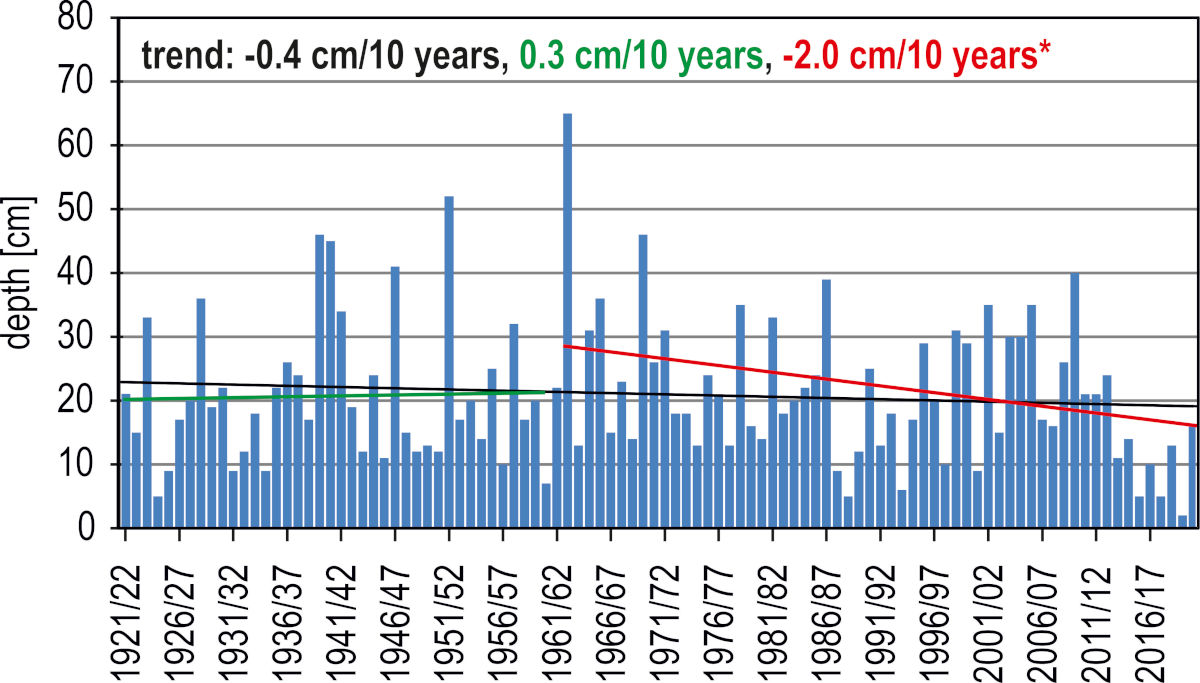The state of snow cover is the result of simultaneous impact and variability of many meteorological elements and factors, such as air temperature, precipitation, solar radiation, and indirectly also atmospheric circulation. Snow cover can therefore be considered as an indicator comprehensively reflecting the conditions of the winter period, and its changes and variability – as an indicator of winter climate change.
The team composed of dr hab. Katarzyna Piotrowicz, prof. UJ from the Institute of Geography and Spatial Management of Jagiellonian University and dr hab. Małgorzata Falarz, prof. UŚ from the Institute of Earth Sciences of University of Silesia studied changes and variability of snow cover in Krakow in the 100-year period 1921/22-2020/21 and in its two sub-periods covering the years of the slow and rapid territorial, urban, and industrial development of Krakow (respectively: 1921/22-1960/61 and 1961/62-2020/21). The long-term variability of the number of days with snow cover, the maximum depth of the snow layer, the dates of the beginning and end of snow cover duration in the winter season, the potential snow cover duration and the index of snow cover stability were analysed.
The directions of changes in the snow cover in the last 100 winter seasons in Krakow correspond to the global changes in air temperature presented in the latest IPCC reports: until the end of the 1950s there were no significant trends, or only small trends were observed, while from the beginning of the 1960s rapid changes in the analysed snow cover characteristics have been visible. In the last 60 years (1961/62-2020/21), the impact of global changes in Krakow has been joined by the impact of territorial, demographic, and industrial development of the city, causing significant negative trends in snow cover with relative values of less than -9% per 10 years, both in the case of snow cover duration and its maximum depth in the winter season; these changes are statistically significant. Throughout the whole 100-year period (1921/22-2020/21) and in its second part (1961/62-2020/21), a decrease in snow cover stability has also been observed. The main and direct cause of the negative trends in snow cover in southern Poland is the change in thermal conditions, which show a statistically significant positive trend in the winter and spring. The winter circulation of the atmosphere is also important, especially the western circulation, which brings relatively warm air from the Atlantic to southern Poland.
The research was financed under the Small Projects 2022 competition from the reserve of the Director of the Institute of Earth Sciences.
Reference:
Piotrowicz K., Falarz M., 2023.The change and variability of snow cover in Kraków in a 100-year observation series. Quaestiones Geographicae, 42(3), p. 213-222. https://doi.org/10.14746/quageo-2023-0031
Note author: dr hab. Małgorzata Falarz, prof. UŚ







![Territorial evolution (a) and number of population (b) of Kraków (based on Mydel [1994], Jelonek [1956] and GUS [2022]). Territorial evolution (a) and number of population (b) of Kraków (based on Mydel [1994], Jelonek [1956] and GUS [2022]).](https://us.edu.pl/instytut/inoz/wp-content/uploads/sites/37/NOTKI/Figure1s.jpg)